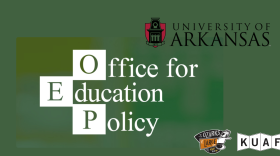Congress is in the midst of negotiating a new farm bill, which provides billions of dollars in food and agricultural programs. One of those programs - the Emergency Food Assistance Program is looking double its funding. Vince Hall, government relations officer for Feeding America, said the spending is necessary as more Americans turn to food banks for help. Hall spoke with Ozarks at Large's Daniel Caruth last week.
The following is an edited transcript of their audio conversation.
Daniel Caruth: So Vince, you know, it's time to kind of fight over the farm bill again in Congress. Can you just walk through, you know why this is something that Feeding America is talking about how it impacts hunger and food security, and why it's a mantle that you guys want to take up?
Vince Hall: Well, the farm bill is a vitally important piece of legislation that comes around only once every five years, and has programs that are vitally important to farmers. But also important to food banks. chief amongst those is the Emergency Food Assistance Program, sometimes called TIF app. And this program, bridges the gap from local farms, to local food banks helping to move healthy fresh foods that are important to our mission of solving hunger, to the food banks that are going to distribute them in rural and urban communities, throughout Arkansas. And we're asking that Congress consider doubling its investment in the Emergency Food Assistance Program, and make it possible for food banks to serve every family in need. The truth is, food banks are seeing some of the highest demand they've ever seen even higher than the peak of the pandemic. And so it's really important that Congress helped us to close the gap between the food that's donated and the food that is needed to solve hunger.
DC: Yeah, and I want to take a look at just from your perspective, from feeding Americans perspective, what is the state of hunger and food insecurity in the US right now? What are we seeing? Is it getting worse than it has been in the past few years, and maybe who's most affected by that who's most vulnerable?
VH: You know, according to data from USDA, hunger has soared in the United States, particularly since some of the pandemic era programs have been rolled back, just in Arkansas, 15% of households are now food insecure. And distressingly, the rate is higher for children, with about one out of every five children in Arkansas struggling to have enough to eat on a regular basis. So we're very concerned about that. And when you look at the number of people facing hunger, it becomes obvious that there are people in everybody's life, whether they know it, or not, who are struggling with hunger, it could be a child and our kids classroom, it could be a neighbor, or a co worker, it could be a military family that stationed in a community but not paid enough to afford to live in that community, a senior citizen who's struggling in their golden years to have dignity and quality of life, or even just somebody who has fallen on hard times and is anxious to get back on their feet, whatever is going on, it's difficult for anybody to to learn and thrive in school, or to perform well on the job if they begin and end the day on a on an empty stomach. And so Feeding America food banks are working very hard, throughout Arkansas, throughout the country, to make sure that people have access to the healthy, nutritious food they need to thrive.
DC: And I want to also look at, as you know, Arkansas, we're a fairly rural state, can you just talk about why hunger is more common in rural areas, and what that type of hunger looks like compared to maybe a suburban or urban area.
VH: With rural hunger, you're talking about communities that are smaller in number, more remote. And inflation has really taken a bite out of food banks ability to cost effectively reach every quarter, but yet they still do it, they're still committed to it. But the cost of fuel to move trucks out to those communities, the cost of labor, the cost of cold storage, because a lot of what food banks are doing is not just shipping, canned and boxed food, but also shipping, fresh produce and healthy proteins. So all of these costs are higher in rural communities. But rural counties make up about 63% of all counties in the United States. But 87% of the counties with the highest rates of food insecurity are rural counties. So not only is the cost of solving rural hunger higher for food banks, but the need in rural communities is higher. And that combination is a is a difficult challenge that food banks readily accept, but we're trying to educate Congress to that reality so that they will support a bigger investment in the emergency food assistance program during this upcoming Farm Bill.
DC: Yeah. And so can we talk about that a little bit. What are the increases that that you guys are looking for in this farm bill to that emergency assistance Food Program, and how will that money be used? What are the specifics of that?
VH: Sure. So currently, the emergency food assistance program is about $450 million per year of federal spending. We're seeking to double that to about $900 million per year. And then over the five year life of the farm bill that would be adjusted annually for inflation. That money is principally used to purchase crops from farmers and to move those crops, those finished products, canned goods, fresh produce dairy products, to local food banks, it is a significant source of food for those food banks, about 22% of all meals distributed by Feeding America, food banks in Arkansas came from the emergency food assistance program, that's almost 13 million meals in one year. So it is a really, really important source of pallets of food on the loading dock of a food bank, that they can then move out to their faith based partners and to their nonprofit partners, who distribute that food directly to families in need, where it's not distributed directly by the food bank. Without that additional investment, we are deeply concerned that there is going to be shortages in the coming years, because we see sustained high demand, unfortunately. But we also see a tightening of the supply chain. We've seen reductions in donated food in some places. And we've seen reductions in the amount of funds that are donated to food banks. So inflation causes more families to face food insecurity. But it also makes it more expensive for food banks to solve food insecurity. And Congress can help to plug that gap through the emergency food assistance program.
DC: And what is the political will look like at the at this juncture? You know, what is the likelihood of this bill getting passed in the form that you guys are hoping for?
VH: Well, it's a great question, Daniel. I mean, we we find it hard to predict what Congress will do. In the past, the farm bill has been a bipartisan piece of legislation, there has been a coming together of both parties around the farm bill in ways that are supportive of the Emergency Food Assistance Program. We are very optimistic and hopeful that if everybody comes together, if we all use our voice collectively, that we can achieve a doubling of the Emergency Food Assistance Program funding in the Farm Bill, the consequence of not doing it could be very significant and bad for our neighbors that are that are facing hunger. The benefits of doing it are enormous, including lower health care costs and better learning in school and better performance on the job. There are so many benefits from solving hunger. There are there are no benefits from turning a blind eye to hunger. So we're hopeful that everybody will use their voice, everybody will come together and help us to achieve this policy goal in the Farm Bill.
DC: And then finally, you know what, what needs to happen to address some of these beyond the Farm Bill, what needs to happen to address some of those underlying issues of food insecurity and hunger in the US.
VH: While we have to start asking some some very deep questions about why it is that people who are working two jobs and some cases working two jobs and picking up gig economy work, who are who are the hardest working people you'll ever meet in your life are still struggling with food insecurity. About 40% of the people that came to food banks during the pandemic had never been to a food bank before. And many of those families have found it very, very difficult to stop relying on charitable food assistance. So they have essentially worked the food bank into their monthly budget equation because of the higher costs of rent, fuel, energy, healthcare and other essentials. That presents an extraordinary challenge for food banks because we really should be a source of temporary help as people work to get back on their feet and not a sustaining monthly part of of a family's budget. So the underlying issues around wages and retirement security and health care costs and other issues are complex. But the charitable food system is expected to be there and is proud, proud to be there as a safety net for those who find themselves unable to to nourish themselves and their families. Our ability to do that is really dependent on the generosity of local communities, but also on the help that we get from the federal government.








